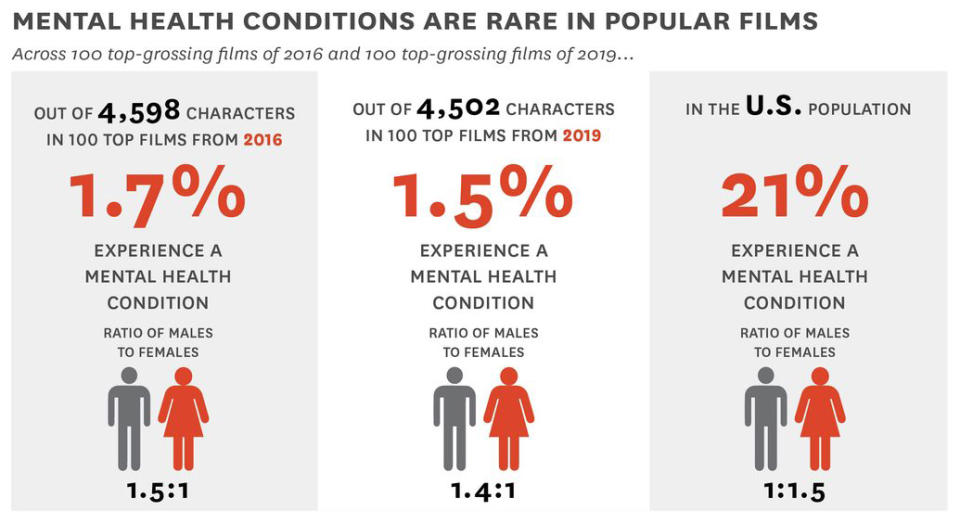Mental Illness Vastly Underrepresented In Popular Films, Study Finds

A new study has found that people with mental health conditions rarely are depicted in Hollywood’s most popular films and that their depiction “remains one of predominantly white, male, straight and able-bodied characters.”
The report, from Dr. Stacy Smith and the USC Annenberg Inclusion Initiative, found that of the 4,502 speaking or named characters across the 200 top-grossing films of 2019, only 1.5% were depicted with mental health conditions, which was down from 1.7% in 2016. By contrast, 21% of U.S. adults experience mental illness, according to national population research studies such as the U.S. National Comorbidity Survey.
More from Deadline
“Stories can provide a window into different worlds and experiences, but the results of this study demonstrate that mental health is rarely a focal point in popular film,” Smith said. “With the growing need for mental health care in the U.S., and the ongoing concern about well-being, storytellers and creatives are missing critical opportunities to educate audiences.”
More than half of the films included in the latest report didn’t feature a single character with a mental health condition, and 30% had only one such character. The report, titled “Mental Health Conditions Across 200 Popular Films,” noted that of those characters depicted with mental health conditions, 59.2% were male and three-quarters were white. Only 16 were from underrepresented racial/ethnic groups, just two were LGBTQ, and 42.3% had a disability.

USC Annenberg
The seven different mental health conditions that were depicted in the 200 highest-grossing films of 2019 included addiction, anxiety/PTSD, depression/mood disorders, suicide, significant disturbances in thinking, cognitive impairment, and obsessive-compulsive disorder. There were more depictions of anxiety/PTSD in 2019 than in 2016, while portrayals of cognitive impairment and spectrum disorders declined, with the remaining mental health conditions remaining consistent with 2016.
“The portrayal of mental health in film has a powerful role to play especially during this period of global mental health crisis,” said Dr. Christine Yu Moutier, chief medical officer at the American Foundation for Suicide Prevention. “Entertainment educates the public, whether it’s with intention or not. And because humans are deeply wired for social connection and imitation, contagion can occur with detrimental effects or with positive impact. Portrayals can not only destigmatize and stop perpetuating dangerous tropes about people who live with mental health conditions, but they can also have the potential to deepen mental health literacy and inspire hope. All people have mental health, and now more than ever, Americans are hungry for information and resources to allow us to not only cope, but to flourish, and to support others’ mental health.”
The report also found that film characters with mental illness often are subjected to derision. Nearly three-quarters of them experienced some form of disparagement, with 45.1% facing derision specifically about their mental health, and more than 40% were the object of jokes or humor related to their mental health, an increase from 22% in 2016.
“The confluence of these contextual factors means that when mental health is presented in film, it is often stigmatized or demeaned,” Smith said. “For audiences, the nature of mental health portrayals may heighten the possibility of negative effects when it comes to real-world outcomes.”
Characters with mental health conditions also frequently were linked with violence: 63.4% were perpetrators of violence, which was up from 46% in 2016, and 66.2% were victims of violence. More than one-third (38%) died at some point in the film, including by homicide or suicide, and 59.3% who perished did so by violent means, including 22.2% who died did so by suicide.
Only 29.6% of characters with a mental health condition were shown in therapy, including individual appointments, group therapy, addiction, support, and inpatient care, while just 12.7% were shown receiving medication or other treatments. Films in 2019 showed more characters receiving both therapy and medication or other treatment than in 2016.
With solutions in mind, the Initiative brought Jay Shetty, a best-selling author and On Purpose podcast host, on board to serve as its chief well-being adviser, where he will serve as a resource to the program and entertainment industry at large on issues of mental health and wellbeing, strategizing new ways to approach the subject matter on-screen and on sets, to work towards positive change.
“It has always been my passion to bridge the gap between mental health and entertainment,” Shetty said. “The access that the Initiative has to further explore these important matters on-screen and on sets and make real systemic change within the industry is what excites me the most.”
Building on its Mental Health Media Guide, the Initiative says it offers “a blueprint for a mental health policy that can be adopted by production companies, studios, and other groups. This policy outlines ways that creative talent, executives, and those overseeing production can tell authentic stories, provide opportunities to nurture mental health for those working in production, and provide audiences with more information on mental health.”
Best of Deadline
Sign up for Deadline's Newsletter. For the latest news, follow us on Facebook, Twitter, and Instagram.